Highlighted Projects
-
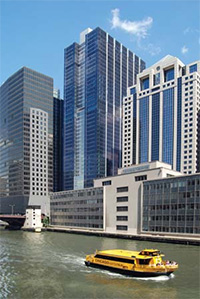
155 North Wacker
155 North Wacker is a 48-story, 1.38-million-sq-ft Class A office tower on the northeast corner of Wacker Drive and Randolph Street in downtown Chicago.
The project is already pre-certified LEED-CS Silver by the USGBC. In addition to offering a technology-enabled infrastructure and efficient floor plates with no interior columns, the building features a covered exterior arcade, a two-story, glass-enclosed lobby, and dedicated tenant amenities including conference and fitness centers, as well as underground parking for 163 cars.
Despite consisting of 8,700 tons of steel and 40,000 cu yd of concrete, the building went up seamlessly. It topped out five weeks early in September, 2008, and the project was completed, on budget, just 22 months after its 10-story predecessor was demolished.
The project team diverted more than 90% of construction and demolition waste from landfills, and more than 25% of the material used on the project came from recycled materials.
More than two-thirds of the new wood used in the project was certified to have been harvested in a sustainable manner.
The floor-to-ceiling glass façade allows abundant daylight to penetrate the office floors. This natural light substantially reduces the energy used for artificial lighting. Low-flow fixtures achieved 40% water use reduction from the baseline case.
In combination with other elements, the building's high-efficiency glazing significantly helped the projected energy performance, achieving a 10.5% reduction in energy usage over typical energy code requirements. Doing so also allowed the project to become one of the first high-rises to obtain a Chicago Green Building Permit, which expedited the permitting process.
-
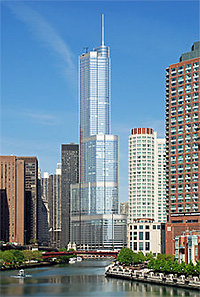
The Trump International Hotel and Tower
The Trump International Hotel and Tower, also known as Trump Tower Chicago and locally as the Trump Tower, is a skyscraper condo-hotel in downtown Chicago, Illinois. The building, named after real estate developer Donald Trump, was designed by architect Adrian Smith of Skidmore, Owings and Merrill. Bovis Lend Lease built the 98-story structure, which reached a height of 1,389 feet (423 m) including its spire, its roof topping out at 1,170 feet (360 m). It is adjacent to the main branch of the Chicago River, with a view of the entry to Lake Michigan beyond a series of bridges over the river.
Trump announced in 2001 that the skyscraper would become the tallest building in the world, but after the September 11, 2001 attacks, the building plans were scaled back, and its design underwent several revisions. When topped out in 2009 it became the second-tallest building in the United States after Chicago's Willis Tower (formerly known as the Sears Tower). It is expected to be surpassed by One World Trade Center in New York City in the middle of 2013. Trump Tower surpassed Chicago's John Hancock Center as the building with the world's highest residence above ground-level and held this title until the completion of the Burj Khalifa. As of 2011 it is the tenth-tallest building in the world.
The design of the building includes, from the ground up, retail space, a parking garage, a hotel, and condominiums. The 339-room hotel opened for business with limited accommodations and services on January 30, 2008. April 28 of that year marked the grand opening with full accommodation and services. A restaurant on the 16th floor, named Sixteen, opened in early 2008 to favorable reviews. The building topped out in late 2008 and construction was completed in 2009. The hotel is one of four in Chicago with a four- or five-star rating, and the building hosts a restaurant that is one of nine restaurants in the city.
-
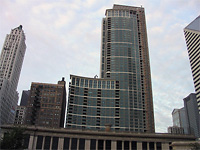
The Heritage at Millennium Park
The Heritage at Millennium Park located at 130 N. Garland Court is a relatively new mixed use tower in Chicago. Completed in 2005 with a height of 631 feet and 57 floors, the building was designed by the architectural firm Solomon Cordwell Buenz.
The tower's success lies mainly with its location; it is directly to the west of Millennium Park, guaranteeing unobstructed views of Millennium Park, parts of Grant Park, and Lake Michigan forever. It is directly opposite the Marshall Field and Company Building on Wabash Avenue. Additionally, the Heritage boasts a private indoor pool, healthclub, dog run, party room, rooftop deck and indoor parking.
In what is becoming common practice with newer buildings, the Heritage preserves and makes use of the façades of four existing buildings in its base. The tower is also special in the fact that both residents and the public can enjoy the tower's inclusion in the extensive downtown underground pedway system. In addition to condominiums, the Heritage also contains ground floor retail space.
-
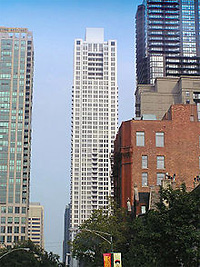
55 East Erie
55 East Erie is an all-residential skyscraper in Chicago. It is at 647 ft (197 m). Designed by Fujikawa Johnson & Associates and Searl & Associates Architects, the 56 story building was completed in 2004 and is the third-tallest all-residential building in the United States after Trump World Tower in New York City, and the nearby 340 on the Park completed in 2007 in Chicago.
The design called for flying buttresses around the mechanical penthouse, which were eventually dropped. Early on, the building was envisioned as much taller in order to house a Mandarin Oriental hotel, but a deal was never struck.
55 East Erie is located one block away from the heart of Chicago's Magnificent Mile. The 56-story condominium tower affords residents views of Lake Michigan and the Chicago skyline.
55 East Erie boasts 194 residential units, including seven floors of split story penthouse homes with express elevator service. The building also features four "Skyhomes," each a unique four story townhome with its own elevator.
Located in Chicago's "Mansion Row" District, the property offers residents a fitness center with towel service, a full length lap pool, a Jacuzzi, and men's and women's locker rooms with saunas and steam rooms. In July of 2009, individual televisions were installed for each piece of cardiovascular equipment. The building has 425 deeded parking spots, as well as an on-site dry cleaner, a bicycle storage facility, and a hospitality room with a full kitchen and outdoor promenade.
Led by a Board of Managers, The 55 East Erie Condominium Association employs a professional staff throughout the building. An experienced on-site management team from Chicago's Sudler Property Management oversees a 24-hour door staff, on-site engineers, and maintenance workers.
-
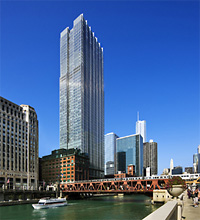
300 North LaSalle
Designed by the internationally recognized firm Pickard Chilton, the 57-story, 1.3 million-square-foot building continues the extraordinary tradition of Chicago architecture. Rising 775 feet from the Chicago River, 300 North LaSalle, among the city's tallest buildings, offers 200 feet of frontage along the river, including an outdoor plaza with seating and a large waterfront café. Other building amenities include a three-level, 225-car garage, a white-tablecloth restaurant, a fitness center, a conference center and a bank. As a certified Gold LEED-CS development, the tower is extremely energy efficient. Its façade is clad in richly articulated glass and stainless steel, maximizing the introduction of daylight and minimizing solar gain.
-
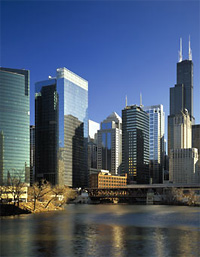
191 North Wacker
Developed by Hines in late 2002, 191 North Wacker is a 37-story office tower with 907,189 square feet of rentable space in the thriving West Loop submarket of Chicago's central business district. Key features of the development include outstanding views of the Chicago River from all floors, enclosed parking for 150 cars, a fitness center and a conference center for tenants. The building is designed to offer distinctive architecture that optimizes tenant views and space planning efficiency while creating a vibrant new image on Chicago's skyline. The project is owned by Manulife Financial, the world's fifth largest life insurance company. Manulife purchased the property from National Office Partners Limited Partnership (NOP), a partnership of the California Public Employees' Retirement System (CalPERS) and Hines in September 2004.
-
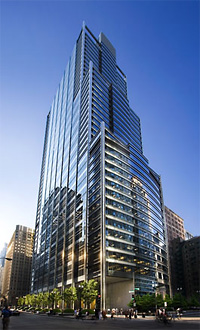
One North Wacker
In 2008, the Hines U.S. Core Office Fund L.P. acquired One North Wacker in the West Loop submarket of Chicago's Central Business District, from a German investment fund managed by RREEF, a unit of Deutsche Bank A.G. The 51-story, 1.4 million-square-foot office tower is located at One North Wacker Drive at Madison Street, in close proximity to Ogilvie & Union commuter train stations. The property was designed by the architectural firm Goettsch Partners, and it was completed in 2001. One North Wacker features a stainless steels and glass exterior and large, highly efficient, virtually column-free floor plates. Building amenities include a 9,000-square-foot conference center and a health club facility. Parking is provided in a two-level, 230-space garage. The building is Certified in the Leadership in Energy and Environmental Design (LEED) program, which is sponsored by the U.S. Green Building Council (USGBC), the nation's leading evaluator for green building.
-
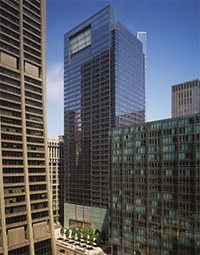
One South Dearborn
In November 2003, Hines broke ground on One South Dearborn, a 40-story, 828,538-square-foot office tower in downtown Chicago. Designed by the architectural firm DeStefano Keating Partners Ltd., the graceful architectural metal and glass tower culminates with a dual-crown lantern soaring 60-feet above the structure. A 16,000-square-foot outdoor plaza clad in Italian granite fronts Dearborn Street and provides entry into a three-story glass and marble lobby. Other amenities include an on-site fitness center, conference facilities, 8,000 square feet of retail space and four floors of above-grade parking that accommodates 160 vehicles. The project was completed in November 2005.
In March of 2006, One South Dearborn received Silver certification in the USGBC's LEED Core & Shell program.
-
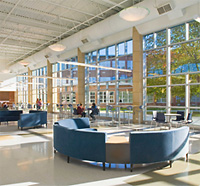
Addison Trail High School
Students get first look at Addison Trail's new look
by Daniel White
http://www.dailyherald.com/story/?id=406400&src=2After all sorts of adversity and uncertainty caused by a construction workers strike, it was time Tuesday for students at Addison Trail High School to enjoy their new digs.
"It's pretty nice, I like it," said student Gazlind Sulejmani of the newly renovated Addison Trial. "I feel like I'm back in California going to school, but we are actually inside. There's better space and more activities, and I can hang out with more friends."
Gazlind was hanging out in the new commons area, part of $115 million in renovations at Addison Trail and Willowbrook High School in Villa Park. On-time completion of the work had been in jeopardy due to the July strike.
But Tuesday's first day of classes appeared to go smoothly. The new amenities certainly didn't hurt.
"One of the things students are excited about this year are the brand new, bigger lockers, which are now 12 inches wide, instead of nine," said Sherri Anderson, director of community relations. "This allows them a better opportunity to store laptops and books"
Addison Trail's improvements include a three-story, 24,000-square-foot classroom addition, the one-story, 20,000-square-foot student commons addition, and a 42,000-square-foot field house addition. Work at Willowbrook includes a one-story, 6,000-square-foot music addition, two stair tower additions and a 42,000-square-foot field house.
-
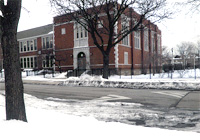
Rufus M Hitch Elementary School
Project makes Hitch School accessible
by Brian NadigFor the first time ever Hitch School, 5625 N. McVicker Ave., will be able to accommodate students in wheelchairs following in recent accessibility improvements at the 85-year-old school, which also received noise abatement improvements at a total cost of about $7.5 million. Hitch principal Deborah Reese said that a new entrance featuring a wheelchair accessible ramp and an elevator was constructed this summer at the north end of the two story building and that a second ramp also installed at an entrance on the west side of the school. Reese said that until the improvements were made, Hitch was unable to enroll students who use a wheelchair and that they would be referred to another school. The school became eligible for an approximately $5 million noise abatement grant from the Federal Aviation Administration following the opening of a new runway at O'Hare Airport which resulted in more planes flying over the school, Reese said. Because of the size of the noise abatement project, a construction permit for that project could not be acquired until the school was brought into compliance with the federal Americans with Disabilities Act. Federal stimulus money from the American Recovery and Reinvestment Act was used to pay for most of the construction cost, with the rest coming from the FAA. The noise reduction measures taken at the school included the installation of interior casement windows behind the existing exterior windows and the installation of a new heating, air conditioning and ventilation system, Reese said. While Hitch did not hold a summer bridge program this summer due to the construction, the school's new air conditioning system will be used if the program returns to the school next year, she said. In accordance with federal guidelines, central air conditioning was not extended to the school office because the noise abatement funds can only be used to make improvements in the sections of a school where learning occurs. After being closed for 2 months because of the construction, the main office at Hitch reopened in mid-August, and the bulk of the construction will be completed by first day of school on Sept. 7. "They've done a great job," Reese said, adding that the areas of new brick blend in nicely with the existing exterior. Enrollment at Hitch is expected to be about 500 this fall. "Ninetynine percent are local, (and) our test scores have gone up," Reese said. In 2009 about 80 percent of Hitch students met or exceeded state test standards.
